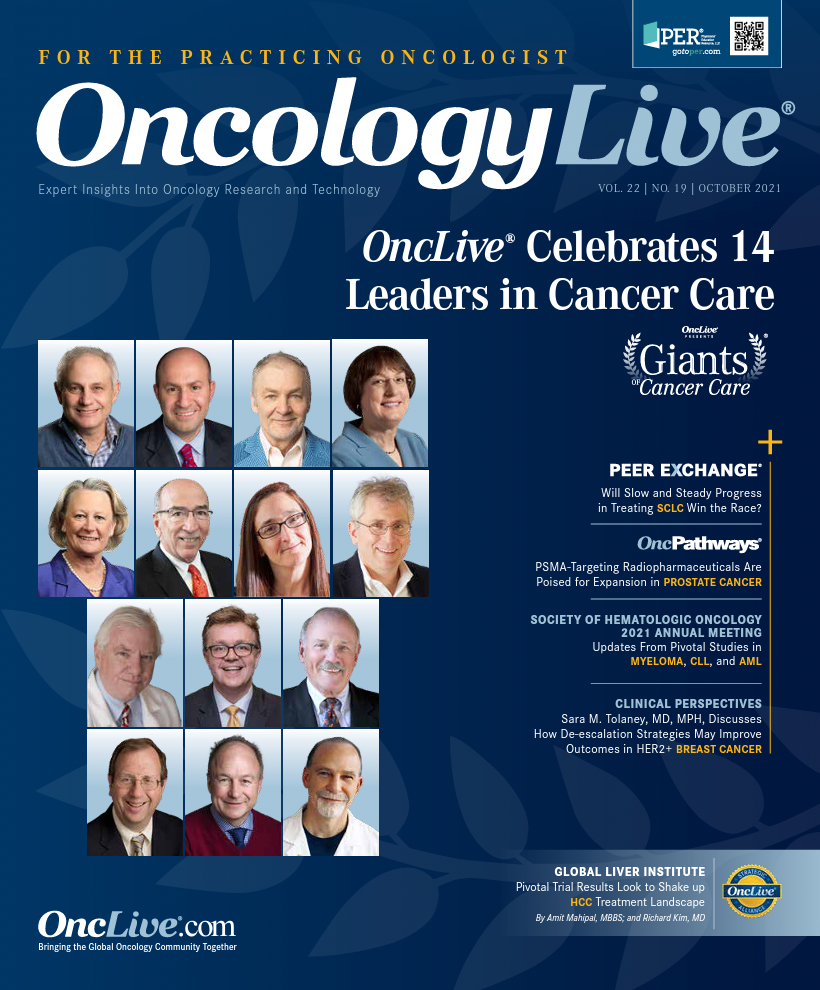Publication
Article
Oncology Live®
Pivotal Trial Results Look to Shake Up HCC Treatment
Author(s):
Hepatocellular cancer, the most common primary liver malignancy, is the fourth-leading cause of cancer-related deaths globally.
Amit Mahipal, MBBS

Hepatocellular cancer (HCC), the most common primary liver malignancy, is the fourth-leading cause of cancer-related deaths globally. HCC is a heterogenous malignancy resulting from diverse causes of chronic liver injury and cirrhosis, with viral hepatitis, alcoholic cirrhosis, nonalcoholic steatohepatitis, and hemochromatosis being the most common etiologic factors. Despite recent advancements in the treatment of HCC, the 5-year survival rate is less than 20%. Surgery and liver transplantation are the primary curative modalities for patients with early-stage HCC; however, a majority of patients with HCC are not amenable for surgical resection or locoregional therapy including ablation, embolization, or radiation therapy.
Until recently, systemic therapeutic options were limited for patients with advanced HCC—sorafenib (Nexavar) was the only FDA-approved therapy for more than a decade. Immunotherapy, tyrosine kinase inhibitors (TKIs), and monoclonal antibodies targeting VEGF have all received FDA approval, broadening the plethora of treatment options for this patient population.
For patients with advanced HCC not amenable for surgical resection, treatment options include locoregional or systemic therapy; there is no role for adjuvant therapy following surgical resection or locoregional therapy for HCC. Investigators are evaluating the role of immune checkpoint inhibitors as adjuvant therapy post surgery, ablation, and embolization in multiple trials. In addition to the stage of disease, performance status and comorbidities, treatment of HCC is guided by Child-Pugh score and Barcelona Clinic Liver Cancer (BCLC) staging system. Historically, locoregional treatment is recommended for patients with BCLC stage B and systemic therapy for BCLC stage C. Benefit of systemic therapy is primarily limited to patients with Child-Pugh score A5 or A6.
Richard Kim, MD

First-Line Treatment
Sorafenib was approved by the FDA based on data from the phase 3 SHARP trial (NCT00105443), which demonstrated an improved median overall survival (OS) of 10.7 months vs 7.9 months with placebo (HR, 0.69; 95% CI, 0.55-0.87; P < .001); the median time to radiologic progression was 5.5 months vs 2.8 months, respectively (HR, 0.58; 95% CI, 0.45-0.74; P < .001).1 These results were validated in another randomized trial (NCT00492752) conducted in the Asia-Pacific region.2 For nearly a decade after the SHARP trial, no targeted therapy demonstrated survival benefit compared with sorafenib as first-line therapy.
Lenvatinib (Lenvima), a small molecular tyrosine kinase inhibitor targeting VEGF, FGFR, PDGFR, RET and c-kit, was compared with sorafenib in a phase 3 randomized inferiority trial (NCT01761266) that included 1492 eligible patients.3 Lenvatinib was associated with improved median progression-free survival (PFS) of 7.4 months (95% CI, 6.9-8.8) vs 3.7 months (95% CI, 3.6-4.6) with sorafenib. The objective response rate (ORR) for patients treated with lenvatinib (n = 478) was 24.1% vs 9.2% with sorafenib (n = 476); however, a similar median OS was reported at 13.6 (95% CI, 12.1-14.9) vs 12.3 months (95% CI, 10.4-13.9), respectively (HR, 0.92; 95% CI, 0.79-1.06). Treatment-related adverse events were similar in both arms.3 This trial led to FDA approval of lenvatinib for patients with advanced HCC in first-line setting.4
Promising activity of immune checkpoint inhibitors in a phase 2 trial led to multiple phase 3 trials in first and later lines of treatment (Table1-3,5-9). Investigators of IMbrave150 (NCT03434379), a phase 3 trial, randomized patients with advanced HCC in 2:1 fashion to atezolizumab (Tecentriq) plus bevacizumab (Avastin) and sorafenib arms, respectively.5 The combination of atezolizumab plus bevacizumab was associated with improved OS (HR, 0.58; 95% CI, 0.42-0.79; P < .001) with 12-month OS rate of 67.2% with the combination (n = 336) compared with 54.6% with sorafenib (n = 165). The median PFS was 6.8 months (95% CI, 5.7-8.3) in the combination arm compared with 4.3 months (95% CI, 4.0-5.6) in the control arm. Notably, patients were excluded if they had untreated or incompletely treated esophageal or gastric varices, autoimmune disease, or coinfection with hepatitis B or C.5
In contrast to above trial, the phase 3 CheckMate 459 trial (NCT02576509) failed to demonstrate a significant survival benefit for nivolumab compared with sorafenib as first-line therapy in unselected patients with HCC.6 Subgroup analysis did suggest potential benefit in patients who had PD-L1–positive tumors.
Combination therapy with lenvatinib plus pembrolizumab (Keytruda) has demonstrated promising activity. Among 100 treated patients the doublet elicited an ORR of 46% (95% CI, 36.0%-56.3%), a median PFS of 9.3 months (95% CI, 5.6-9.7), and a median OS of 22 months (95% CI, 20.4-not estimable) in a single-arm trial (NCT03006926).7 Based on these exciting results, a phase 3 trial evaluating this combination is under way (LEAP-002; NCT03713593).
NR, not reached; OS, overall survival; PFS, progression-free survival; TTP, time to progression.
aDid not reach statistical significance.
bDid not meet prespecified coprimary end point.

Second-Line Treatment
Multiple therapeutic agents are approved for patients with advanced HCC progressing or intolerant to first-line therapy with sorafenib. Regorafenib (Stivarga), cabozantinib (Cabometyx), and ramucirumab (Cyramza), all targeting VEGFR, were approved based on results of randomized phase 3 trials that demonstrated a survival benefit when compared with placebo. The median OS in the experimental arms in these trials was in the range of 8.5 to 10.6 months.
There were some differences in eligibility criteria in these trials. For example, in the RESORCE study (NCT01774344), which compared regorafenib with placebo, patients were excluded if they discontinued sorafenib because of adverse events. To be eligible for the REACH-2 trial (NCT02435433) evaluating ramucirumab, patients should have α-fetoprotein (AFP) levels greater than 400 ng/mL (or > 1.5 times the upper limit). In contrast, the CELESTIAL trial (NCT01908426), which randomized patients to cabozantinib or placebo, is the only randomized trial that allowed patients who had received prior immunotherapy to be eligible.
Immune checkpoint inhibitors have demonstrated limited activity in second-line setting and the FDA has granted acceler-ated approval to pembrolizumab, nivolumab (Opdivo), and ipilimumab (Yervoy) plus nivolumab. The phase 3, randomized KEYNOTE-240 trial (NCT02702401) eval-uating pembrolizumab failed to meet the prespecified composite end point of PFS and OS, despite a longer median OS being reported for the pembrolizumab arm vs placebo (13.9 vs 10.6 months, respectively; HR, 0.781; 95% CI, 0.611-0.998; P = .0238).8
Results of the CheckMate040 trial (NCT01658878) showed that treatment with nivolumab was associated with a median OS of 15.1 months (95% CI, 13.2-18.8) and an ORR of 14% among 154 patients who had previously received sorafenib.9 However, with the negative results of the CheckMate 459 trial in first-line setting, FDA indication of single-agent nivolumab in HCC was withdrawn.10
Further data from a combination arm of CheckMate040 showed that ipilimumab plus nivolumab administered at a dose of nivolumab 1 mg/kg plus ipilimumab 3 mg/kg every 3 weeks for 4 doses followed by nivolumab 240 mg every 2 weeks was associated with longest median OS (22.8 months) and remarkable ORR of 32% (95% CI, 20%-40%) among 50 patients.11 This combination is now being tested in first-line setting in the CheckMate 9DW trial (NCT04039607) and results are eagerly awaited.
Sequencing of Therapy
Systemic therapeutic strategy for advanced HCC continues to evolve. For patients with no contraindication to immunotherapy and without untreated gastroesophageal vari-ces, combination of atezolizumab plus bevacizumab is the recommended first-line treatment.12 For patients who are ineligible to receive this combination, either lenvatinib or sorafenib is a reasonable choice. There is a lack of published data to suggest a preferred treatment option after progression on atezolizumab plus bevacizumab. Thus, optimal treatment sequencing strategy remains undefined.
Our recommendation is to consider atezolizumab plus bevacizumab as first-line therapy; followed by TKI including lenvatinib, sorafenib, cabozantinib or regorafenib as second-line therapy; followed by another TKI which was not used in second regorafenib, cabozantinib, or ramucirumab as third line (Figure). Patients enrolled in the CELESTIAL trial, which examined the efficacy of cabozantinib, could receive more than 1 line of prior therapy, including immunotherapy. If sorafenib was well-tolerated and patients had prolonged disease control, they may preferentially benefit from regorafenib as next line of therapy. The combination of ipilimumab plus nivolumab has demonstrated promising activity but remains untested in patients treated with prior checkpoint inhibitors. Similarly, efficacy of ramucirumab remains unclear in patients who failed bevacizumab in the first line.
Future Directions
There are several areas of unmet need for patients with advanced HCC. For example, benefit with systemic therapy is limited to patients with good performance status with Child-Pugh score 7 or lower, excluding a vast proportion of patients. The development of promising systemic therapies with manageable adverse event profiles suggests that investigators should compare these systemic options with locoregional therapy for patients with high-risk disease. Finally, there is an urgent need to develop biomarkers that can help in selecting patients for different treatment options.
Global Liver Institute (GLI) is the only liver focused nonprofit organization operating in both the United States and Europe. GLI’s mission is to improve the lives of individuals and families impacted by liver disease through promoting innovation, encouraging collaboration, and scaling optimal approaches to help eradicate liver diseases. By working across disease states and convening all stakeholders, GLI aims to amplify the voices of those impacted by liver diseases and cancers. One of these initiatives is GLI’s Liver Cancers Council, in which Dr. Richard Kim is an active and engaged member helping to lead the charge for patient advocacy. For more information and resources please visit https://www.globalliver.org/.
References
- Llovet JM, Ricci S, Mazzaferro V, et al; SHARP Investigators Study Group. Sorafenib in advanced hepatocellular carcinoma. N Engl J Med. 2008;359(4):378-390. doi:10.1056/NEJ-Moa0708857
- Cheng AL, Kang YK, Chen Z, et al. Efficacy and safety of sorafenib in patients in the Asia-Pacific region with advanced hepatocellular carcinoma: a phase III randomised, double-blind, placebo-controlled trial. Lancet Oncol. 2009;10(1):25-34. doi:10.1016/S1470-2045(08)70285-7
- Kudo M, Finn RS, Qin S, et al. Lenvatinib versus sorafenib in first-line treatment of patients with unresectable hepatocel-lular carcinoma: a randomised phase 3 non-inferiority trial. Lancet. 2018;391(10126):1163-1173. doi:10.1016/S0140-6736(18)30207-1
- Nair A, Reece K, Donoghue MB, et al. FDA supplemental ap-proval summary: lenvatinib for the treatment of unresectable hepatocellular carcinoma. Oncologist. 2021;26(3):e484-e491. doi:10.1002/onco.13566
- Finn RS, Qin S, Ikeda M, et al; IMbrave150 Investigators. Atezolizumab plus bevacizumab in unresectable hepatocel-lular carcinoma. N Engl J Med. 2020;382(20):1894-1905. doi:10.1056/NEJMoa1915745
- Yau T, Park JW, Finn RS, et al. CheckMate 459: A randomized, multi-center phase III study of nivolumab (NIVO) vs sorafenib (SOR) as first-line (1L) treatment in patients (pts) with advanced hepatocellular carcinoma (aHCC). Ann Oncol. 2019;30(suppl 5):V874-V875. doi:10.1093/annonc/mdz394.029
- Finn RS, Ikeda M, Zhu AX, et al. Phase Ib study of lenvatinib plus pembrolizumab in patients with unresectable hepato-cellular carcinoma. J Clin Oncol. 2020;38(26):2960-2970. doi:10.1200/JCO.20.00808
- Finn RS, Ryoo BY, Merle P, et al: KEYNOTE-240 Investigators. Pembrolizumab as second-line therapy in patients with ad-vanced hepatocellular carcinoma in KEYNOTE-240: a random-ized, double-blind, phase III trial. J Clin Oncol. 2020;38(3):193-202. doi:10.1200/JCO.19.01307
- El-Khoueiry AB, Melero I, Yau TC, et al. Impact of antitumor activity on survival outcomes, and nonconventional benefit, with nivolumab (NIVO) in patients with advanced hepatocellular carcinoma (aHCC): subanalyses of CheckMate-040. J Clin Oncol. 2018;36(suppl 4):475. doi:10.1200/JCO.2018.36.4_suppl.475
- Bristol Myers Squibb statement on Opdivo (nivolumab) monotherapy post-sorafenib hepatocellular carcinoma U.S. indication. News release. Bristol Myers Squibb. July 23, 2021. Accessed September 3, 2021. bit.ly/2XnbB3A
- Yau T, Kang YK, Kim TY, et al. Efficacy and safety of nivolumab plus ipilimumab in patients with advanced hepatocellular car-cinoma previously treated with sorafenib: the CheckMate 040 randomized clinical trial. JAMA Oncol. 2020;6(11):e204564. Published correction in JAMA Oncol. 2021;7(1):140. doi:10.1001/jamaoncol.2020.4564
- NCCN. Clinical Practice Guidelines in Oncology. Hepatobiliary cancers, version 4.2021. Accessed September 3, 2021. bit.ly/3tP1OiQ










